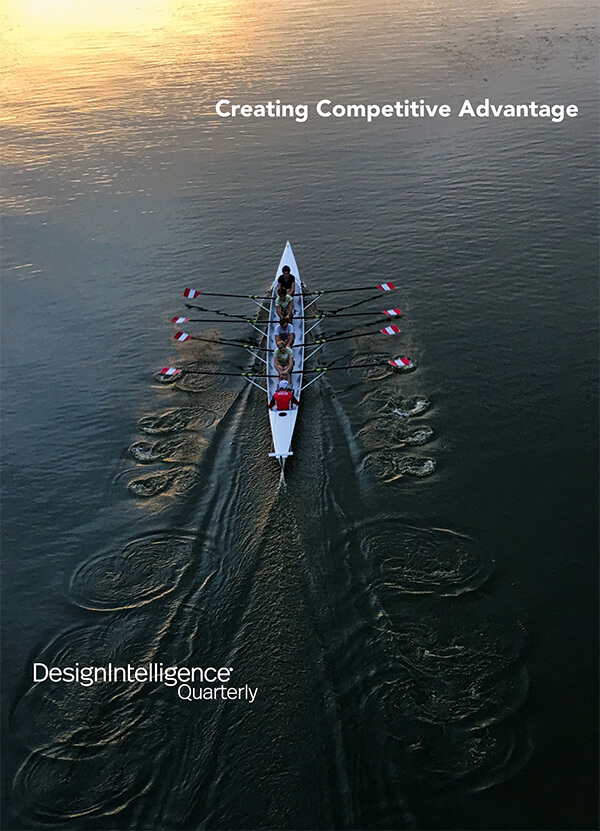Creating Competitive Advantage
by Scott Simpson
Senior Fellow, Design Futures Council
May 26, 2021
Every design firm suffers from the illusion that it is unique. While each one certainly has distinguishing characteristics, there are far more similarities than differences.
All firms must respond to certain externalities (market conditions and building codes, to name just two) and all of them provide essentially the same basic professional services and deliverables using commonly accepted contract terms. In this sense, a firm’s willingness to conform to conventional standards is a prerequisite for success. So what is it that sets firms apart? What causes clients to choose one over another? What really creates competitive advantage?
Every design firm has an inherent brand—a set of shared perceptions and expectations that convey what the firm promises to deliver. There are two dimensions to every brand: internal and external. The internal brand is the firm’s self-image—what it sees (or prefers to see) when it looks in the mirror. The external brand exists in the minds of clients and the larger market—it’s the mirror looking back. Sometimes there is close alignment between the two, but more often than not there are discrepancies. Understanding the difference is essential.
Self-awareness starts by looking outward rather than inward—by developing a deep understanding of clients and the markets in which they operate. Regardless of their location, type, size, or specialization, all firms share one thing in common: they need clients to exist. What do clients really want? What are their business drivers? It’s critical to understand how clients are organized and who the key decision-makers are. Every client has hot buttons—and you need to know what they are. Research their track record with regard to hiring architects, engineers, and construction managers.
What are your clients’ long-term capital spending plans? Do they habitually deliver their projects on time and within budget? It’s also important to assess market conditions: the external factors that shape their business strategy, and how they respond when these conditions change. And what new ideas or technologies may disrupt their industry? These are the kinds of questions that every firm should be asking all the time, because the ability to develop a deep understanding of the client’s point of view is the very first step in the design process and the basis of how your firm can deliver unexpected value.
Gaining insight about competing firms
is equally important. Which ones are
particularly adept in certain markets, project types, or clients? What is it that they do well? Look for insight into how are they organized
to deliver professional services and what their cost structure is. Some firms are primarily design-driven, whereas others are service-driven
or technically-driven. Who are their key people, and which contractors and consultants do they work with most frequently? (Teaming with the
right consultants is a great way to build competitive advantage.) Also do some research about how they handle the entitlement and approvals
process, and their track record with regard to on-time, on-budget performance. If they have any weaknesses, what are they? How does your
firm stack up by comparison?
The insights gained from doing the homework on markets, clients, and the competition are invaluable; they provide clues about how to make your firm stand out. Start with the realization that all firms are good at some things (otherwise they would not be in business) but no firm is good at everything (even though some think that they are!). Design firms tend to be most successful if they are organized around a set of core values and principles that are clearly articulated, well understood, and fully embraced by the staff. This is the cultural DNA of the organization and the basis of its brand. Many firms claim to strive for “design excellence” and promise to “exceed expectations,” but all too often these sound more like slogans than credible promises (especially when everyone else uses the same jargon). What is your firm’s unique value proposition—the thing it does better than any other firm—and how can you back up that promise with actual results? These are the questions that clients are asking when they decide which firm to hire.
Now that the context, the players, and the market dynamics are understood, the next step is to position your firm for best advantage. Think of this as a chess problem; where do you want to arrange your pieces on the board? Decide what you are trying to achieve and how you will make it happen. What do you want the firm to look like? How big should it be? Which markets and clients are the best fit, given the firm’s interests, talent base, and business strategy?
While you are considering these issues, make sure to factor in the client’s point of view. After all, the essence of competitive advantage is not how you see the market, but rather how the market sees you. Then decide, and play to your strength. Bear in mind that deciding means not only what to include, but what to leave out. Wasting time doing things that are “off brand” creates confusion in the minds of the staff and clients alike; this is needlessly distracting and saps the organization’s energy and focus.
Next, look at the nuts and bolts of the operation. To create true competitive advantage, everything about the firm, from marketing to management to how it delivers professional services, should reflect and reinforce the overall brand. Decide up front what it is that you want prospective clients to know ... and then tell them. What are you particularly good at? Make the message clear, concise, and compelling. Give people a reason to pay attention, and reinforce the message often. (And remember that if you do not tell people what you want them to know, they will supply their own narrative, whether or not it is accurate.) The most important thing is to back up the message with actions rather than slogans.
For example, if design is your firm’s forte, then make sure that your work gets published, and tell the story of how your firm’s innovative approach to design created real value. If delivering projects on time and within budget is your primary calling card, then provide real data to back up the claim. Explain how your process works, comparing actual results with industry standards. This works particularly well with clients who are cost-sensitive or habitually have trouble meeting their performance benchmarks. If technical innovation is your driver, then demonstrate what it can do for your clients on their next project. In short, make your message come alive by connecting your passion with the client’s mission. The trick is to do this without hubris. Take special care to frame your message from the client’s point of view. (It’s not about you!) Be specific about the benefits that will accrue if your firm is selected, then make sure that those promises are kept.
Today’s marketplace is highly competitive, and attention spans are short. Clients are inundated with a wide array of viable choices, and it’s difficult for them to separate signal from noise. To break through, you not only need to have a great story to tell, you have to tell it to the right people. Focus on the key decision makers. If you perform as promised, your clients will become your best marketers.
Scott Simpson is a Senior Fellow in the Design Futures Council and a regular contributor to DesignIntelligence.


